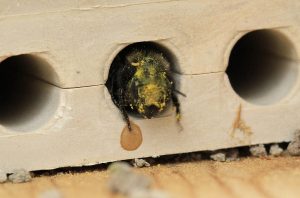Support Us
Since 1979 more than 140,000 animals have been treated by Wildlife Rescue.
Thanks to the support of individuals like you, Wildlife Rescue can provide a lifeline for animals in distress.
Blue Orchard Mason Bees are expert pollinators and DON’T sting (the males don’t even have a stinger). They are metallic blue/black and are smaller than typical honeybees (so they look like flies). Bee populations have dropped by 50 percent in the last 25 years! Habitat loss, climate change and pesticides have all contributed to this decline. But we can help by making backyard habitats for these solitary critters!
Re-useable Mason Bee Home Materials

Remember to build with an adult!
Thoroughly clean it, inside and out. If using an empty coffee can or similar, remove the lid but leave the bottom intact. If using a flowerpot, cover the drainage hole with paper and tape.
Create a nesting tube by first cutting, then rolling the tissue rolls (or paper) snugly around a pencil to make a sturdy tube. Secure with a few pieces of tape, and gently slide out the pencil. Close one end of the tube by covering it with tape.
Place each nesting tube inside the container with all open ends facing out. If available, add moss in the gaps between tubes for insulation, support and a comfortable environment. Tie the string tightly around the container so you can hang it. (Or punch holes in the side of the container and knot the string inside)
Choose a south-facing spot in your yard that will be protected from rain, and hang it about eye level. Trees and fence posts are natural choices if available.
In the summer or fall careful take out the rolls and empty the bee cocoons from them. Store cocoons in a dark and cool place until early spring when you will set them beside your bee house, with brand new tubes that you now know how to make!